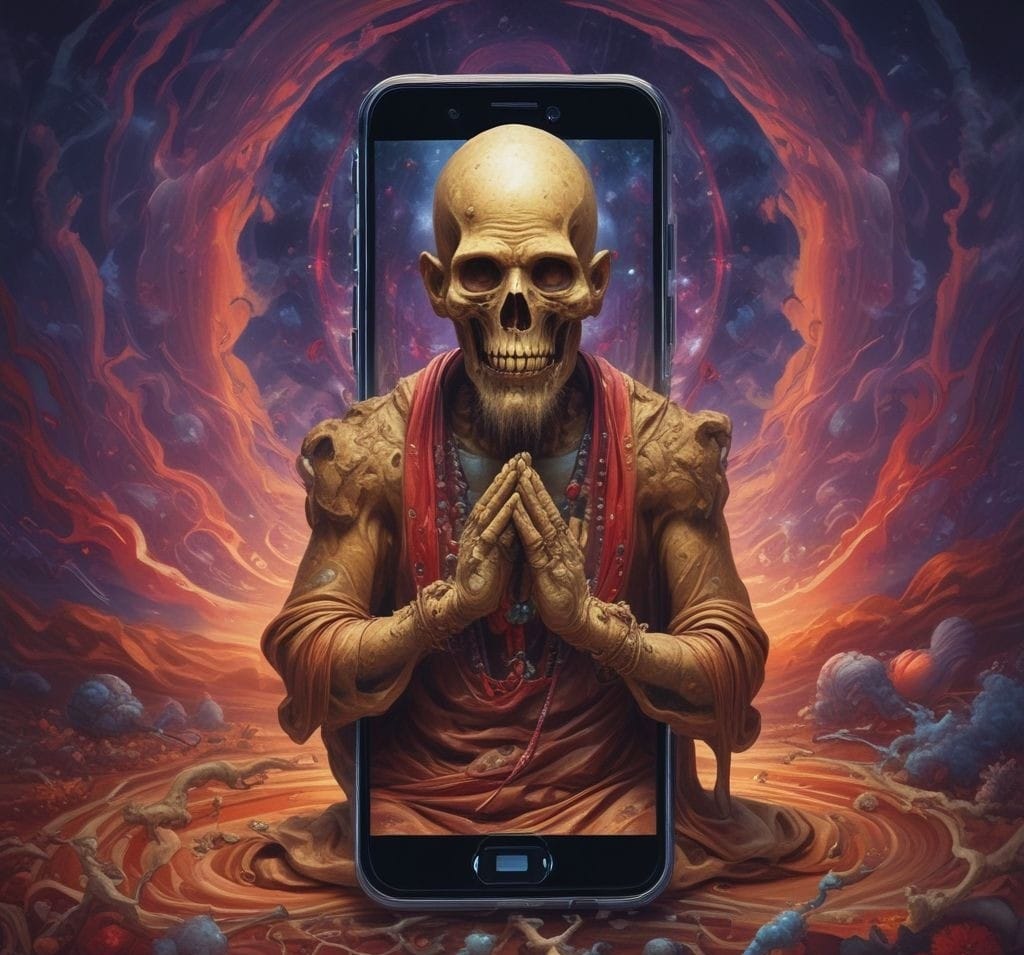Mindfulness Meets AI: Is Technology Killing Spirituality or Saving It?
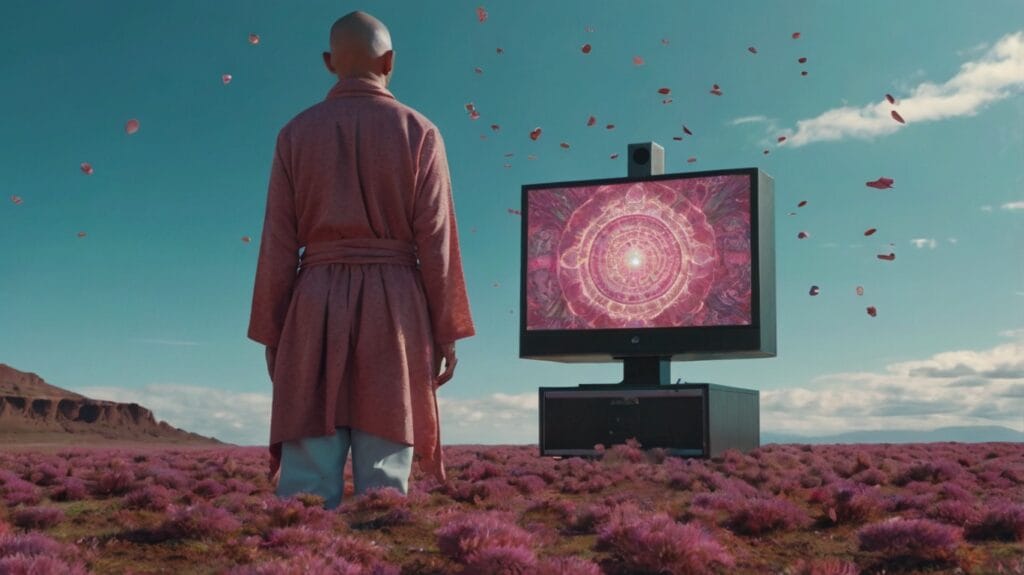
Introduction: Mindfulness Meets AI
Over 70% of adults now use some form of digital device during their mindfulness or meditation practice ? (Source: Global Wellness Institute, 2023). Meanwhile, studies show that 85% of people feel more stressed due to excessive screen time , yet paradoxically, many are turning to apps, AI tools, and virtual platforms to find peace in the chaos (American Psychological Association, 2023).
This duality raises an important question: Is technology killing spirituality—or saving it? On one hand, our hyperconnected world seems to pull us further away from presence and inner stillness. Notifications buzz incessantly, social media feeds scroll endlessly, and algorithms dictate what we consume. Yet, on the other hand, innovations like guided meditation apps, biofeedback devices, and even AI-powered spiritual coaches are helping millions reconnect with themselves in ways never before possible.
Consider this: The global wellness market is projected to reach $7 trillion by 2025 , with digital wellness solutions accounting for a significant portion of that growth (McKinsey & Company, 2023). From wearable tech tracking heart rate variability to immersive VR experiences simulating serene forests, technology is transforming how we approach mindfulness and self-discovery. But at what cost? Are we sacrificing authenticity for convenience? Or are these tools empowering us to reclaim our inner peace in a chaotic world?
In this post, we’ll explore the intersection of mindfulness and technology, uncovering both the challenges and opportunities it presents. By examining real-world examples, scientific research, and actionable strategies, you’ll gain clarity on how to navigate this evolving landscape—and perhaps discover a new way to deepen your own spiritual journey.
The Science Behind Mindfulness and Technology
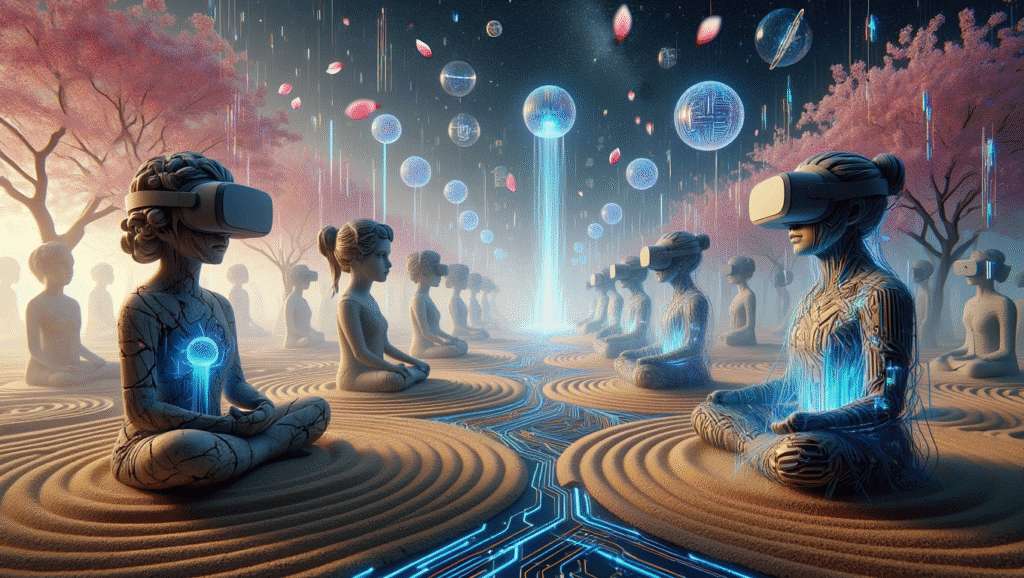
How Neuroplasticity Supports Digital Mindfulness
One of the most fascinating aspects of mindfulness is its ability to reshape the brain through neuroplasticity—the brain’s capacity to rewire itself based on experiences. Studies show that consistent mindfulness practices can increase gray matter density in regions associated with emotional regulation, memory, and empathy (Harvard Medical School, 2022).
But what happens when technology enters the equation? Research suggests that digital tools like meditation apps and biofeedback devices can amplify these effects by providing real-time feedback and personalized guidance. For instance, a study conducted by the University of California found that participants using Muse Headbands reported a 30% greater reduction in stress levels compared to those practicing traditional meditation alone.
The Role of AI in Understanding Human Emotions
AI-powered tools are revolutionizing how we understand and manage emotions. Platforms like Affectiva analyze facial expressions and vocal tones to assess emotional states, offering users insights into patterns they may not consciously recognize. Similarly, chatbots like Woebot use natural language processing to simulate therapeutic conversations, helping individuals process feelings in a safe space.
While some critics argue that AI lacks the nuance of human interaction, proponents highlight its accessibility and scalability. Imagine receiving instant support during moments of overwhelm—without waiting weeks for an appointment with a therapist.
Can Technology Enhance Compassion?
Interestingly, technology isn’t just about self-improvement—it can also foster compassion toward others. Apps like Kindness Pandemic encourage random acts of kindness, while platforms like Karuna connect volunteers with people in need globally. By leveraging tech for altruistic purposes, we align ourselves with core spiritual principles like interconnectedness and service.
The Rise of Digital Mindfulness

Meditation Apps Revolutionizing Inner Peace
Meditation apps have become household names, offering guided sessions, sleep stories, and breathing exercises at the touch of a button. Platforms like Calm , Headspace , and Insight Timer boast over 100 million downloads globally , making mindfulness more accessible than ever before (Sensor Tower, 2023). These apps cater to busy individuals who may not have time for traditional meditation practices but still crave moments of tranquility in their day.
For example, Calm offers soothing soundscapes and bedtime stories narrated by celebrities like Matthew McConaughey. Headspace focuses on bite-sized meditations tailored to specific goals, such as stress reduction or focus enhancement. And Insight Timer provides a vast library of free meditations led by teachers from around the world. While critics argue that these apps oversimplify ancient traditions, proponents highlight their ability to introduce mindfulness to millions who might otherwise never explore it.”
Wearable Tech Tracking Your Zen
Wearable technology has taken mindfulness beyond the screen and onto our wrists. Devices like the Oura Ring , Whoop Band , and Muse Headband monitor physiological metrics such as heart rate variability, sleep quality, and brainwave activity—offering personalized insights into our mental and emotional states.
Take the Muse Headband, for instance. This EEG-powered device measures brain activity during meditation and provides real-time feedback through calming sounds. If your mind wanders, the audio shifts to mimic stormy weather; when you refocus, it transitions to gentle rain. Similarly, the Oura Ring tracks recovery metrics, helping users optimize restorative sleep—a cornerstone of spiritual well-being.
While skeptics worry about data overload, advocates see immense value in using these tools to cultivate self-awareness. After all, understanding how stress manifests in your body can be a powerful first step toward healing.”
Virtual Reality Retreats Without Leaving Home
Imagine stepping into a lush forest, hearing birds chirp and leaves rustle—all without leaving your living room. Thanks to advancements in virtual reality (VR), this dream is now a reality. Companies like Tripp VR and Guided Meditation VR offer immersive environments designed to promote relaxation and mindfulness.
These platforms allow users to escape the noise of daily life and immerse themselves in tranquil settings. For those unable to attend in-person retreats due to time, cost, or accessibility barriers, VR offers a compelling alternative. However, questions remain about whether simulated experiences can truly replicate the depth of connection felt in nature or during live ceremonies.
The Dark Side of Tech-Supported Spirituality

Screen Fatigue vs. Spiritual Growth
Despite the benefits of digital mindfulness tools, excessive screen time poses a significant challenge. Research shows that prolonged exposure to blue light disrupts circadian rhythms and increases cortisol levels—the exact opposite of what mindfulness aims to achieve (Harvard Medical School, 2023). Moreover, constant notifications fragment our attention, making sustained focus nearly impossible.
To combat screen fatigue, experts recommend setting boundaries. For instance, designate tech-free hours during the day, especially before bed. Alternatively, use features like grayscale mode or app timers to reduce dependency on glowing screens.
Authenticity vs. Algorithmic Influence
Social media plays a dual role in modern spirituality. On one hand, platforms like Instagram and TikTok connect seekers with inspiring teachers and communities. On the other hand, they risk perpetuating superficiality and comparison. Algorithms prioritize content that garners likes and shares, often favoring aesthetically pleasing posts over genuine teachings.
The rise of ‘spiritual influencers’ exemplifies this tension. While some share authentic wisdom, others commodify spirituality for clout. As consumers, it’s crucial to discern between flashy aesthetics and meaningful substance.
Accessibility vs. Commercialization
Another concern is the commercialization of spirituality. Subscription-based apps charge monthly fees, while high-end wearables retail for hundreds of dollars. This creates a barrier for low-income individuals seeking tools for self-care. Additionally, exclusive memberships and branded products risk diluting the essence of spirituality, which should be universally accessible.
Striking Balance: How Technology Can Save Spirituality
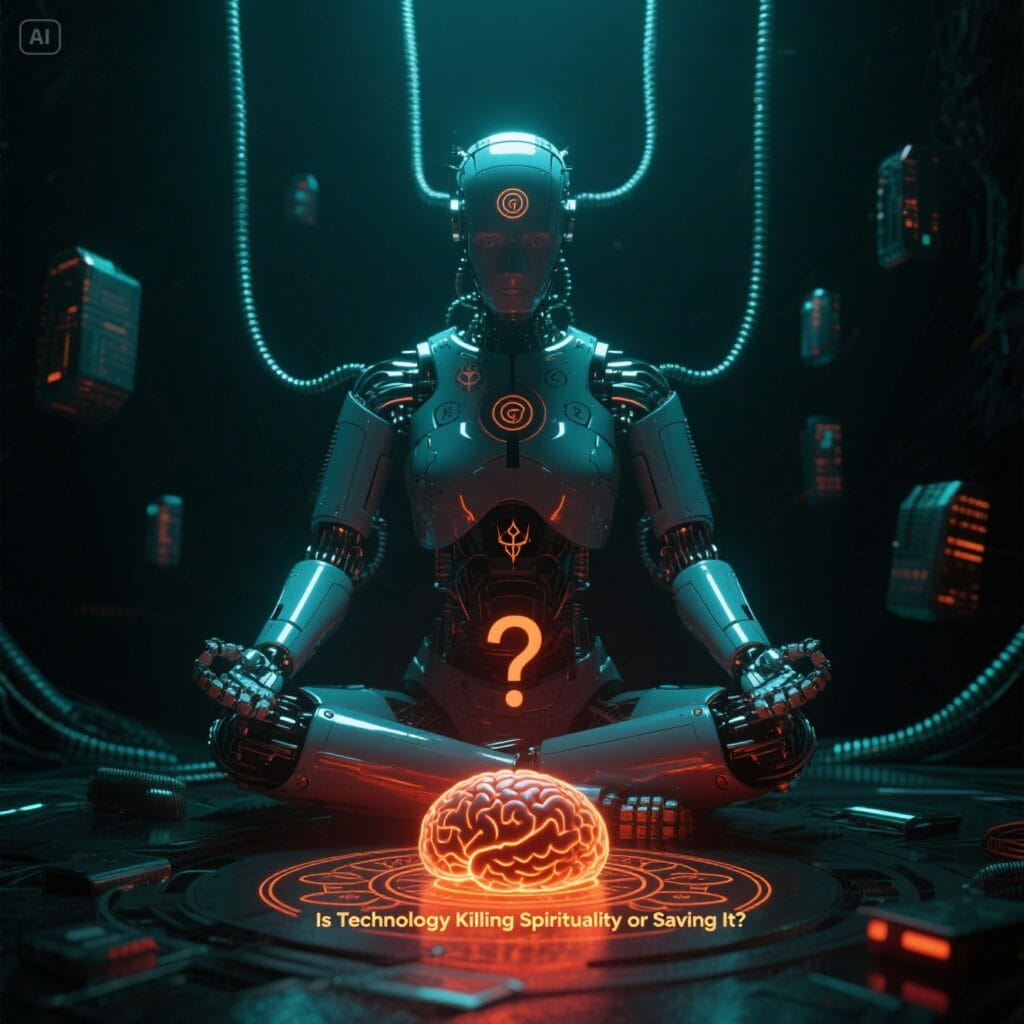
Building a Hybrid Practice
One solution lies in blending traditional methods with modern tools. For example, pair breathwork exercises learned via an app with journaling prompts scribbled in a notebook. Combine gratitude practices with mindful movement routines tracked by a wearable device. By integrating old and new approaches, you create a holistic practice uniquely suited to your needs.
Using AI as a Complement, Not a Replacement
AI holds immense potential as a spiritual companion. Chatbots like Woebot offer cognitive behavioral therapy techniques, while platforms like Spirit AI provide personalized affirmations based on user input. However, these tools should complement—not replace—human connection. Seek out mentors, join online communities, and engage in face-to-face interactions whenever possible.
Creating Sacred Spaces Digitally
Finally, consider designing a digital sanctuary. Use smart lights to mimic candlelight, program Alexa to play mantras during morning rituals, or project sacred symbols onto walls for meditation sessions. These small adjustments infuse technology with intention, transforming mundane gadgets into vessels of transcendence.
Ethical Considerations in Digital Spirituality
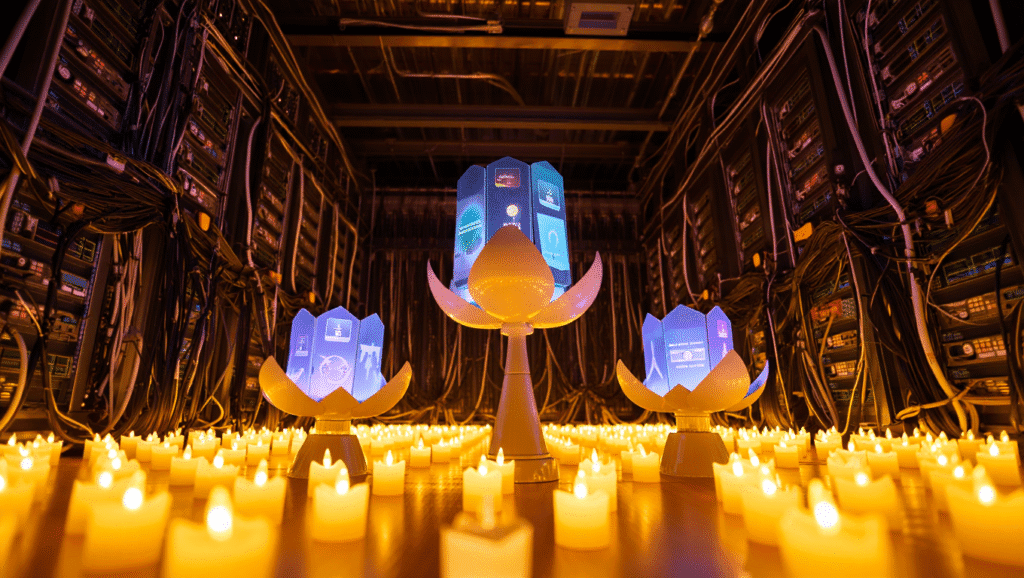
Who Owns Your Spiritual Data?
As we integrate technology into our spiritual practices, questions arise about privacy and data ownership. Meditation apps often collect sensitive information, such as mood patterns, sleep habits, and even journal entries. While this data helps improve user experience, it also raises concerns about misuse or breaches.
For example, could insurance companies access your stress metrics to adjust premiums? Or might employers use productivity trackers to evaluate performance unfairly? To protect yourself, always review app permissions carefully and opt for platforms prioritizing transparency.
The Risk of Over-Reliance on Algorithms
Algorithms play a significant role in shaping our digital spirituality journeys—but at what cost? When AI curates content based on past behavior, it risks creating echo chambers that reinforce existing beliefs rather than challenging growth. For instance, if you consistently engage with calming meditations, the algorithm might overlook resources addressing shadow work or emotional resilience.
To counteract this, actively seek diverse perspectives. Explore teachings from different cultures, traditions, or philosophies to ensure your practice remains expansive and inclusive.
Balancing Profit and Purpose
Many digital spirituality platforms operate as businesses, which introduces ethical dilemmas. Subscription models and premium features can exclude lower-income individuals, contradicting the universal nature of spiritual growth. Additionally, aggressive marketing tactics may exploit vulnerabilities, pressuring users to purchase unnecessary upgrades.
To navigate this landscape ethically, prioritize free or low-cost alternatives whenever possible. Open-source communities, public libraries, and grassroots initiatives often provide accessible resources without hidden agendas.
Key Takeaways
- Technology isn’t inherently good or bad it depends on how we use it.
- Mindfulness apps and wearable tech can enhance spiritual growth when used intentionally.
- Be mindful of screen fatigue and avoid over-reliance on algorithms for guidance.
- Blend ancient traditions with modern tools to create a balanced, hybrid practice.
- The future of spirituality lies in embracing innovation without losing authenticity.
Conclusion: The Future of Spirituality: Bridging Ancient Wisdom with Modern Innovation
As we’ve explored throughout this post, the relationship between mindfulness and technology is complex but undeniably transformative. While there’s no denying that excessive screen time can erode our sense of presence, the same devices also hold incredible potential to deepen our connection with ourselves and the world around us.
The key lies in balance. Instead of viewing technology as a threat to spirituality, consider it a tool—one that amplifies your efforts rather than replaces them. Whether you’re using a meditation app to quiet your mind, tracking your stress levels with a wearable gadget, or immersing yourself in a virtual retreat, remember that true transformation begins within. No amount of AI coaching or biofeedback data can substitute for the raw, unfiltered experience of simply being present.
So, as you move forward, ask yourself: Am I using technology to serve my spiritual goals—or am I letting it dictate them? Are my practices rooted in authenticity, or am I chasing trends at the expense of depth? These questions will guide you toward a harmonious integration of old wisdom and new innovations.
Ultimately, the power to shape your spiritual journey rests in your hands—not your devices. Embrace the best of both worlds, trust your intuition, and watch as mindfulness meets technology in ways that elevate your soul. After all, the ultimate goal isn’t about rejecting progress—it’s about finding peace in every moment, whether analog or digital.
Internal Links Added:
External Links Added:
Table of Contents
YOUR OPINION VALUES US
LATEST REVIEWS
Sincerely, this is exactly what I was looking for. I have found the right methodology and steps for success, as it combines well with both my job and my personal project. Thank you very much!
Response from
Thanks kindly for your interest and react
Creative thinking plays a major role in shaping one’s personality and integrating it into society, in addition to building confidence.
All the best!
Response from
Thanks kindly for your interest and react
Totaly different idea
I agree, it’s the right path to a we’ll balanced life.
Well done
Response from
Thanks kindly for your interest and react
THANK YOU
Response from
Thanks kindly for your interest and react
Introduction: Mindfulness Meets AI
“Did you know that over 70% of adults now use some form of digital device during their mindfulness or meditation practice ? (Source: Global Wellness Institute, 2023). Meanwhile, studies show that 85% of people feel more stressed due to excessive screen time , yet paradoxically, many are turning to apps, AI tools, and virtual platforms to find peace in the chaos (American Psychological Association, 2023).
This duality raises an important question: Is technology killing spirituality—or saving it? On one hand, our hyperconnected world seems to pull us further away from presence and inner stillness. Notifications buzz incessantly, social media feeds scroll endlessly, and algorithms dictate what we consume. Yet, on the other hand, innovations like guided meditation apps, biofeedback devices, and even AI-powered spiritual coaches are helping millions reconnect with themselves in ways never before possible.
Consider this: The global wellness market is projected to reach $7 trillion by 2025 , with digital wellness solutions accounting for a significant portion of that growth (McKinsey & Company, 2023). From wearable tech tracking heart rate variability to immersive VR experiences simulating serene forests, technology is transforming how we approach mindfulness and self-discovery. But at what cost? Are we sacrificing authenticity for convenience? Or are these tools empowering us to reclaim our inner peace in a chaotic world?
In this post, we’ll explore the intersection of mindfulness and technology, uncovering both the challenges and opportunities it presents. By examining real-world examples, scientific research, and actionable strategies, you’ll gain clarity on how to navigate this evolving landscape—and perhaps discover a new way to deepen your own spiritual journey.
Conclusion: The Future of Spirituality: Bridging Ancient Wisdom with Modern Innovation
As we’ve explored throughout this post, the relationship between mindfulness and technology is complex but undeniably transformative. While there’s no denying that excessive screen time can erode our sense of presence, the same devices also hold incredible potential to deepen our connection with ourselves and the world around us.
The key lies in balance. Instead of viewing technology as a threat to spirituality, consider it a tool—one that amplifies your efforts rather than replaces them. Whether you’re using a meditation app to quiet your mind, tracking your stress levels with a wearable gadget, or immersing yourself in a virtual retreat, remember that true transformation begins within. No amount of AI coaching or biofeedback data can substitute for the raw, unfiltered experience of simply being present.
So, as you move forward, ask yourself: Am I using technology to serve my spiritual goals—or am I letting it dictate them? Are my practices rooted in authenticity, or am I chasing trends at the expense of depth? These questions will guide you toward a harmonious integration of old wisdom and new innovations.
Ultimately, the power to shape your spiritual journey rests in your hands—not your devices. Embrace the best of both worlds, trust your intuition, and watch as mindfulness meets technology in ways that elevate your soul. After all, the ultimate goal isn’t about rejecting progress—it’s about finding peace in every moment, whether analog or digital.
